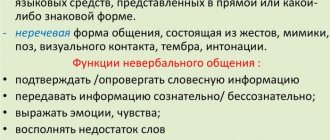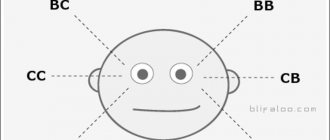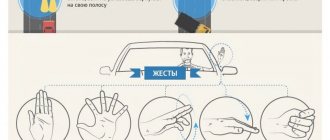Man is such an interesting creature that all manifestations of his essence, personality and feelings are perceived with interest. Facial expressions, for example, can tell a lot of interesting details about people, even if they themselves are silent. Gestures can also reveal someone else’s state. By observing people, you can learn many interesting details that will help you understand the truth or lies, emotions, mood and other characteristics of those around you. The psychology of facial expressions is truly extensive. To study it fully, one article or even a book is not enough. Nevertheless, some rules and tips will help you learn at least basic psychological “tricks” for use in the future.
General information and definitions
Physiognomy is the art of reading a person by his external signs, in particular by his face, his expression, features and facial expressions. You can determine both internal qualities and some psychological data, as well as health status. This method cannot be called completely scientific, but many are very seriously interested in it due to its certain validity. Facial expressions are facial expressions in which a person reveals his inner sensations, experiences, feelings, mood, emotions and other spiritual qualities. Gestures are body movements, most often with the hand/hands, that accompany or replace the words of the individual performing them. Posture is the position of the body. A person sits, stands or lies the way he likes/convenient/comfortable.
Gestures, postures, facial expressions - all this plays an important role in people's lives. Not a single person can live without them, and therefore, if you learn to recognize them correctly, life will become easier and more interesting. Facial expressions and gestures in communication are used everywhere and automatically; not everyone is able to control them. Thanks to this, more observant and attentive individuals have the opportunity to study people.
Sadness
The expression of sadness on the face is usually easily recognized by the downturned corners of the lips and eyebrows
. Sadness is usually associated with feelings of loss and helplessness. The expression of sadness on the face often appears in people who withdraw into themselves.
The origin of this facial expression is quite simple: a person’s emotions seem to weaken, he droops, thus his facial features also fall down. Sadness can also be an indication of defeat
, a feeling of reluctance to communicate with others.
Do you feel sad and despondent? Food may be to blame!
Face and facial expressions
What tells you best about a person? Of course, the face. It is this that is capable of giving away a person when he experiences some emotions, reacts to something, lies or tells the truth, etc. The language of facial expressions is rich and varied. It can be difficult to remember absolutely everything, but elementary features of sincere joy, for example, or disappointment can be retained in memory. And also learn to hide your own feelings. Despite the fact that human facial expressions and gestures are closely interrelated, they will be considered separately. So, let's go.
Astonishment
The expression of surprise is easy to recognize by the wide open eyes and mouth. The feeling of surprise or shock is close to the feeling of fear. Surprise is one of our most instinctive emotions
, which is reflected in facial expressions. Most of the time, our facial expression changes unconsciously, but when we are surprised, the reaction on our face can appear instantly.
All primates, as well as many other animals, roll their eyes
when experiencing fear or anxiety.
10 Little-Known But Important Human Senses
If something unexpected happens to us, our eyes open wide and our pupils enlarge so that we can better orient ourselves in space.
, and also respond faster.
Reactions
Human facial expressions manifest themselves in different ways, and most often they can be seen in human emotions. The latter, in turn, are shown in reactions. Depending on their manifestation, you can find out what a person experiences from the information received. The difficulty is that some are afraid, others don’t want to, and still others are embarrassed to show their own emotions. Because of this, you will have to have time to notice the quick, involuntary reaction that appears very first. It is often almost impossible to completely control it, especially for an unprepared person. Therefore, you can determine the real feelings of your interlocutor, which he will most likely remove from his face in seconds, if you act quickly and extremely carefully.
How to apply knowledge about microfacial expressions?
What does this facial expression mean?
Given that each emotion manifests itself differently, remembering all the features is not so easy. Practice and patience play a big role. Remember the expressions of one emotion, and look for its manifestations in the eyes of your interlocutor. To understand this science, you can even practice on a close friend or loved one. Watching him, draw a conclusion, and then ask whether you were right in your judgments.
If you want to understand a person's thoughts, start with the elementary: look into his eyes! It is this part of our face that is the mirror of the soul. It is almost impossible to fake the sparkle in the eyes, so they testify to a person’s attitude towards the events around him.
Do not forget about the connection between facial expressions, posture and gestures that a person shows. The presence of sincere emotion is manifested in the complete harmony of these non-verbal signs. If an imbalance occurs, this indicates the manifestation of lies.
Possible mistakes:
- The idea that you can understand the emotions of any person. There are people who know how to control themselves and their every move. Often these are “gamblers” or chess players, whose success directly depends on restraint and self-control.
- Generalization. Do not forget about the mentality, culture and nationality of a person. It is difficult to make a German smile, but this does not indicate insincerity, while Americans cannot calmly react to a “stony expression” on their face.
- Jumping to conclusions based on just one emotion. Each person is individual, so it is recommended to get to know the person better before drawing conclusions.
- Recognition of a person’s thoughts is used when communicating with a stranger, a teenage child, a boss or subordinates, and on first dates with the opposite sex. In these situations, it is extremely important to know what the other person is thinking!
Emotions
So let's continue. As mentioned just above, facial expressions in communication are manifested through the expression of emotions emanating from a reaction. Below are the most striking and significant of them, as well as ways of expressing them:
- Joy happiness. The eyebrows and lips are relaxed, the corners of the latter are raised on both sides, the cheeks are also raised, and there are small wrinkles in the corners of the eyes.
- Anger, irritation. The eyebrows are tense, brought together and lowered, the mouth is tightly closed. Often the teeth are brought together, as are the lips, the corners of which look down during anger or strong dissatisfaction.
- Contempt. Smirk. The corner of the mouth is raised on one side and a slight squint is visible in the eyes.
- Astonishment. The lips and face are generally relaxed, the eyes are rounder than usual, the eyebrows are raised up, and the mouth is slightly open.
- Fear. The eyebrows and upper eyelids are raised, and the lower ones are tense, like the whole face as a whole, the eyes are wide open.
- Sadness, disappointment. Slightly lowered upper eyelids and raised eyebrows, relaxed lips with corners looking down, as well as an empty, dull look.
- Disgust. The upper lip is tense and raised, the eyebrows are brought together, forming a small fold, and slightly lowered, the cheeks are also slightly raised, and the nose is slightly wrinkled.
Among other things, pictures will help you deal with emotions. The facial expressions on them are depicted well, which clearly demonstrates the inner feelings and experiences of the people depicted. Smiles, by the way, were also not invented in vain. Their facial expressions are often quite good, which is why they are in demand when trying to convey emotions via the Internet. After all, communication here mainly takes place in letters, which are not always able to convey the sensations experienced at one time or another.
Physiognomy at the present stage of development
Initially, physiognomists studied the features of the entire human body, but now facial features have become the focus of researchers.
In the field of view of researchers only congenital features of appearance:
- Shape, size, location of facial features
- Birthmarks
- Color of the skin
- The presence of various kinds of bulges and dents
- Wrinkle lines
- Scars
Convinced adherents of physiognomy believe that by learning to understand what information is embedded in facial features, you can learn a lot of new and useful information.
Human condition
Sometimes it is enough to observe people a little to see what they are like. Facial expressions affect a person, and not only “one-time”, but for the rest of his life. The more clearly your interlocutor showed himself, the more you can find out about him. — Smart people most often have a large forehead. This does not mean that their knowledge is great in everything. Sometimes it happens that a person knows a lot of information in one area, but is completely ignorant in another. If your friend has a large forehead, but does not show any signs of special intelligence, perhaps he simply has not yet found his business.
— Brilliant eyes and a lively look mean that a person is passionate about someone/something. This usually happens to curious children who are interested in everything in the world. On the contrary, if a person’s gaze is dull and indifferent, it means that he is depressed, perhaps close to depression.
— If a lot of wrinkles appear in the corners of the eyes when laughing, this means that the person is kind, cheerful and cheerful.
— Bitten lips mean that a person likes to think and is most often nervous when making a decision. Sometimes people automatically begin to act this way right in front of their interlocutor, because they cannot decide something.
— A firm, developed chin (often square) shows a person’s strong will. Because people, when achieving their goals (even in an argument), tense the lower part of the face, it begins to develop. With frequent victories, the chin becomes strong and firm, which proves a person’s ability to achieve his goals. Based on this, if the lower part of the interlocutor’s face is soft, weak and undeveloped, it can be assumed that he is easy to break. He will not go to the end if a serious obstacle appears ahead.
— The more various bulges, irregularities, “hollows”, “protrusions”, etc. on the face (sunken cheeks, prominent cheekbones, for example), the more emotional and hot-tempered a person is. He can easily fall into a state of passion and vividly and vividly throw out his experiences on those around him.
Percentage of identical photo ratings in each culture
Rice. 2 . Examples of photographs used in a study of how emotions are assessed by educated members of different cultures
| USA (J=99) | Brazil (J=40) | Chile (J=119) | Argentina (J=168) | Japan (J=29) | |
| Fear | 85% | 67% | 60% | 54% | 65% |
| Disgust | 92% | 97% | 92% | 92% | 90% |
| Joy | 97% | 95% | 95% | 98% | 100% |
| Anger | 67% | 90% | 94% | 90% | 90% |
We conducted a series of experiments in the highlands of southeastern New Guinea, where we could find people who met our criteria. Because these people had never taken psychological tests or participated in experiments, and because we did not know their language and worked through translators, we were forced to modify the experimental procedure. In other countries, we simply showed a photograph of one or another expression of an emotion and gave the observer the opportunity to choose the name of the emotion from a ready-made list. In New Guinea, we showed the observer three photographs at once, and the interpreter read a fictitious story associated with that emotion (for example, “This man's mother died”) and asked the observer to show the photograph that corresponded to that story. We found that all of these people chose the same face for the same emotion, just as people did in all the other cultures we surveyed. There was one exception: the people of New Guinea did not distinguish between facial expressions of fear and surprise.
In a similar experiment, other Guineans were told a story associated with an emotion and each of them was asked to show how the emotion was expressed on their face. We made video recordings of these intentional expressions of emotion, four examples of which are shown in Fig. 3. The analysis again showed that the same facial expressions were used to display the same emotions, which was consistent with the results obtained in other cultures, with the exception of fear and surprise, emotions that Guineans consistently confused. Further evidence for the universality of facial expressions came from a study conducted in another culture in the western part of the island of New Guinea. Carl and Eleanor Heider, skeptical of our evidence for the universality of emotional expression, conducted the same experiments with people who were even more visually isolated from the world than those we studied, and also found evidence of universality.
As a result, our research, Izard's research, the Heider couple's research and the results obtained by Eibl-Eibesfeldt (an ethnologist who used completely different methods) convincingly showed that Darwin was right about the existence of universal facial expressions of emotion.
Figure 3.
Video footage taken during our attempts to capture the emotions of the people of New Guinea. Each photograph had its own “legend”: the top left - “Your friend came to you and you are glad to see him”; top right - “Your child has died”; lower left - “You are angry and ready to fight”; lower right - “You see a dead pig that has been lying here for many days”
Although the facial appearance for each basic emotion is common to all people, immediate facial expressions may vary across cultures in at least two ways. What in itself causes emotions usually turns out to be different; In different cultures, people may experience disgust or fear in response to different stimuli. In addition, cultures differ in the conventions that people try to adhere to when trying to control or manage their facial appearance in specific social situations. People in two different cultures may feel sadness when a loved one dies, but one culture may dictate that the main mourners mask their sadness with expressions of mild joy on their faces.
Gesticulation
Both facial expressions and gestures in communication make it clear what and how a person says:
- Open palms signify trust and openness. If a person periodically exposes the inside of his hand to you, it means that he has nothing to hide from you, and he feels good in your company. If the interlocutor constantly hides his hands in his pocket, puts them behind his back, or makes other similar “secretive” movements, he is probably not very comfortable. This could be either dislike towards you or guilt/shame for past actions.
- Hands placed near the cheek mean thoughtfulness. Usually at such moments a person thinks intensely about something, tries to figure out what to do in a given situation, etc.
- When nervous or, more likely, lacking self-confidence, a person begins to touch either his neck or objects on it such as a pendant, chain, etc. In addition, he may begin to chew on the handle.
- A nod of the head signifies agreement. Sometimes people nod uncontrollably, thereby communicating on a subconscious level that they like someone else's opinion. Shaking your head, on the contrary, means that the person does not agree with you. Just like nodding, sometimes it happens automatically.
Shame
The facial expression when a person is ashamed of something is recognizable all over the world. It involves downcast eyes with an expression of sadness or worry
. The head and corners of the lips are usually also lowered down. Sometimes a person covers his face with his hands. The expression of shame is very similar to the expression of submission.
In a group of primates, once someone assumes a dominant position, the rest of the group becomes subordinate, their eyes and heads downward, signaling the end of the conflict.
Secrets, shame and guilt
In our complex society, failure is usually divided into personal and competitive. For example, we may be defeated (and feel shame) in a game, or if our hopes are not met,
or if we do not live up to what other people expect of us.
All this can be expressed in completely different ways, but the feeling of shame is always present when we admit defeat
.
Poses
Open facial expressions and gestures in communication are, of course, good, but we must not forget about the postures a person takes during a conversation:
- If a person sits relaxed, with his legs stretched forward, in your direction, this means that he is in a favorable mood. Approaching your interlocutor with a chair has the same meaning: a predisposition towards you personally and the conversation as a whole.
- Sometimes a person unfastens buttons, or even takes off clothes, such as a jacket. This proves his trust and open attitude towards you.
- If your interlocutor draws something simple on a piece of paper, often looks at one point, fiddles with a pen, shakes his leg, taps his fingers, does not express any special emotions, etc., it means that he is not very interested in you, because this signs of boredom. Change the topic of conversation or try to add liveliness to the dialogue.
- Crossed legs or arms (on the chest, for example) mean closedness, withdrawal, reluctance to communicate and open up. Perhaps the person simply feels uncomfortable, and this condition will soon pass, or perhaps it is unpleasant for him to be in your company.
Treatment with a smile
A real, sincere smile is always symmetrical and begins with the eyes. The artificial one appears only on the lips and disappears from the face too slowly or too quickly. Subordinates smile at such dominants. Just like we smile at people we see for the first time. Unfortunately, even a sincere but too wide smile (that shows teeth) can be misinterpreted - e.g. at the interview. When you smile like that during business negotiations, your interlocutors may also not understand the reasons for your satisfaction or be suspicious of you.
See also: JEALOUSY is a feeling associated with love that can be destructive
How to recognize truth and lies from a person
That’s why many people are interested in the details of our article - everyone wants to know how to read a person’s facial expressions, how to see when they are blatantly lying to you, and when they are telling the pure truth. Some ways to expose a liar are given below, but remember that, perhaps, the liar has known about such tricks for a long time, and therefore uses them skillfully and dexterously, deceiving others in such a way that a mosquito will not undermine his nose.
- When a person tells a lie, his pupils involuntarily constrict. If you have previously noticed the initial state of the interlocutor’s eyes, then you will understand that he is being disingenuous after the pupils become smaller.
- When a person lies, he looks away. This happens because he is subconsciously ashamed of the false information he says.
- When a person is lying and knows about the previous method, he looks intently into the eyes. Most often, he gets so “played” that he barely even blinks. This can also reveal a liar.
- The gaze of a lying person moves from one object to another, without stopping at one thing. Sometimes it's just a sign of nerves, but more often it's a sign of lies.
- Thanks to the compression of the zygomatic muscles, a kind of half-smile, half-grin appears on the face of the lying person.
- The direction of your gaze will also tell you whether you are hearing the truth or a lie from your interlocutor. If a person looks to the right, most likely, you are being presented with a lie, if to the left, the truth. However, this rule applies provided that the speaker is right-handed, otherwise read backwards.
Fear
When a person experiences a feeling of fear, his eyes open wide and his eyebrows rise high on his forehead. The mouth usually also opens wide. Fear, like surprise, is closely related to instincts
and indicates a desire to avoid something.
One scientific study that took place in 2008
, was dedicated to the facial expressions of a person who experiences fear.
The results showed that people who feel fear inhale more air
and are able to complete tasks much faster due to the fact that their eyes are wide open.
Thus, facial expression enhances sensory perception
.
Man's greatest fears
Showing a feeling of fear on your face turns out to be quite a practical behavior that helps a person avoid dangerous situations.
, enhancing his feelings.
Features of foreign language of facial expressions and gestures
Not everywhere they communicate in the same ways as here. Of course, this does not mean human language, but the language of gestures, postures and facial expressions. The list below, indicating specific countries and incorrect actions, will help you avoid getting into trouble with foreigners. Asia. Watch your arms and legs. You should not be the first to touch someone else’s head and hair, because for Asians this is the most sacred thing in a person. The legs, in turn, also don’t need to be loosened, though not at all. Even an accidental touch (to any part of the body) can cause panic and even anger on the part of Asians. This is because, unlike the head, the legs are considered the “lowest” thing in the human body. Near East. Giving a thumbs up is the same as giving a person a punch in the ass. Children, however, often show this gesture, thereby trying to tease others. Brazil. The “everything is okay” gesture (the thumb is connected to the index finger, forming a zero, and the remaining fingers stick out “out”) here has approximately the same meaning as our middle finger. Venezuela. The “everything is okay” gesture here denotes homosexuality. Italy. The “Goat” gesture from rock music here signifies betrayal and failure. That is, if you show this sign to someone, you are hinting that you consider him a complete loser who is being cheated on by his other half. In northern Italy you are also not allowed to touch your chin, as this means you are giving the person the middle finger. Fiji. A handshake is considered a trademark of the republic, which is why you should not be afraid if the interlocutor holds your hand tightly and for a long time in his. This is just a sign of politeness, and it can really last a considerable amount of time, right up to the end of the conversation. France. The “everything is okay” gesture here denotes homosexuality, and scratching the chin is the same middle finger.
Anger
Expressing anger, more than any other emotion, is common to people of all cultures and nations. The appearance of a person in anger and his behavior are unmistakably guessed
: the eyebrows frown, the eyelids tense, the head is usually slightly lowered down, the gaze is from under the brows.
Anger is associated with unpleasant, annoying and disappointing situations. This is a very primitive feeling that is common to many species of animals.
. Our expressions of anger are similar to those of other primates, and the facial expressions are incredibly similar.
Expressing anger extends your life by 2 years
Facial tension is usually combined with body language, which allows other people to better understand our emotions
. As social creatures, we have the ability to influence the mood of other people.
If a person experiences anger in a company, he unmistakably stands out from the crowd, and the rest begin to feel tense
. The facial expression that shows tension and irritation coincides with what the person is experiencing inside himself.











